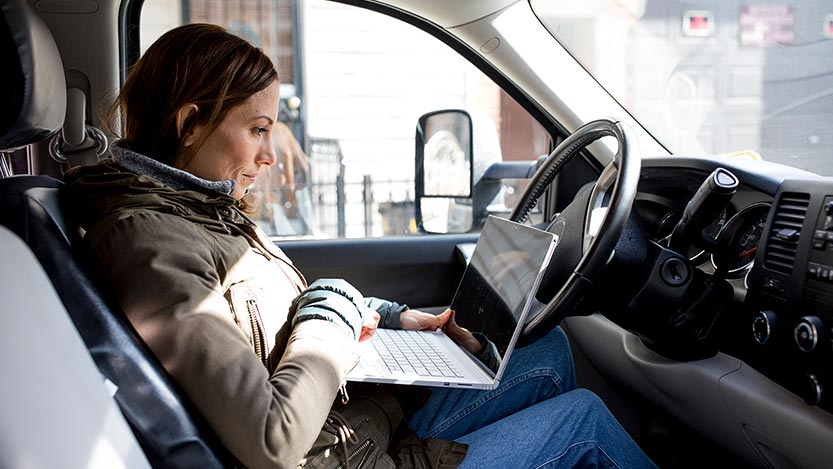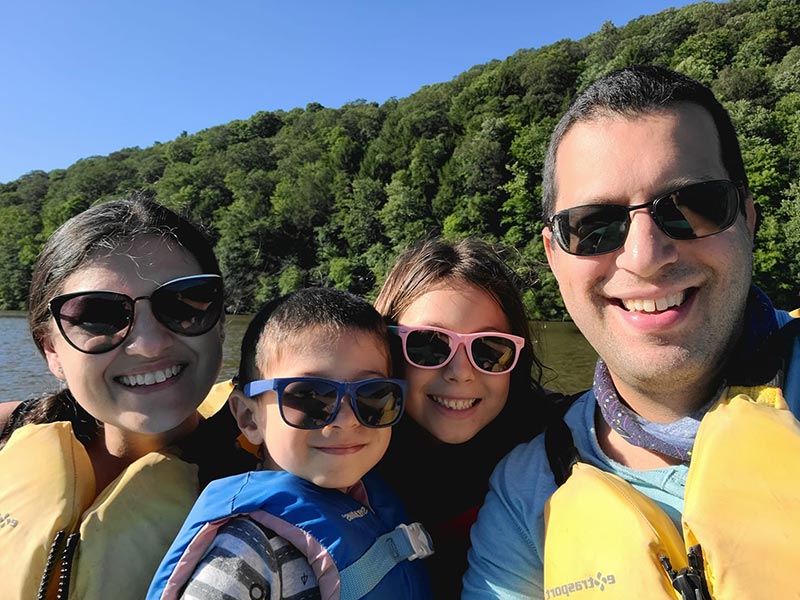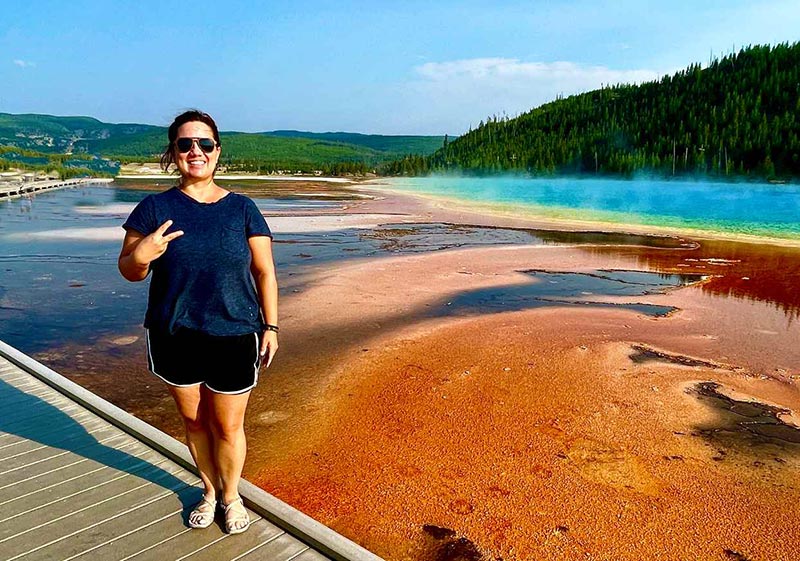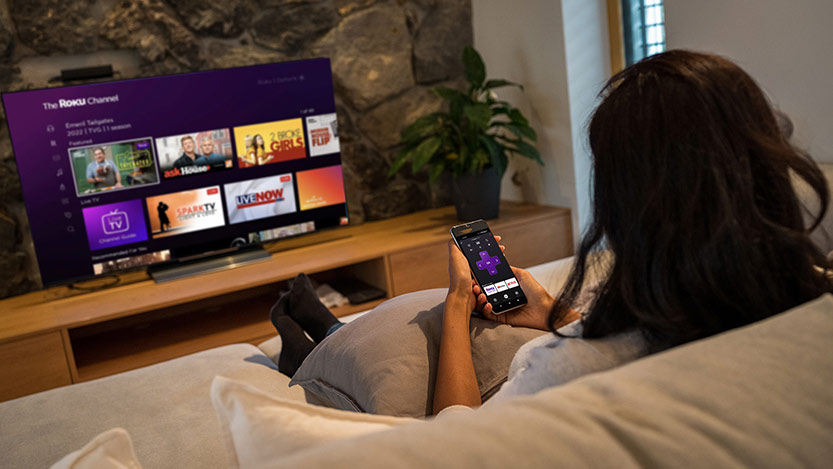Blog post
How technology and hybrid work drive the Digital Nomad trend

So far, Rachelle Olden has been to 52 countries, a few in the last year alone. Since she can work remotely, she can do her job anywhere and explore as many places as desired—so that’s what she’s doing. Olden, Product Marketing Manager on the Microsoft Advertising Experiential Marketing Team, is part of a growing trend of remote workers known as Digital Nomads, about whom you can learn more in the free Life Reinvented: Emerging Consumer Behaviors e-book.1 She’s not alone out there—according to a study by MBO Partners, there are 10.9 million Digital Nomads in the U.S. and 19 million more considering starting the lifestyle.2
You’ve likely seen Digital Nomads on social media or heard about them in the news. They share pictures from the beach, laptop resting on their legs, palms trees swaying in the background. Or maybe they’re at a campsite, working out of the back of a remodeled van, strings of twinkling lights overhead as they join a Microsoft Teams meeting.
You’ve also probably wondered, “Who are these people who travel all the time while working, and how do they do it?”
Digital Nomadism explained
Thanks in part to the pandemic and the hybrid online lives to which we’ve adapted, Digital Nomadism is a growing trend, and an interesting and valuable audience marketers are starting to consider. Digital Nomads are location-independent people who make a living working online. Because they work 100% remotely, they can constantly move from place to place while staying connected to the office (if there’s an internet connection). They’re working in coffee shops, temporary rentals, recreational vehicles, and modified vans. They work from beaches, farms, suburban homes, temporary apartments, boats, campsites, adapted busses, and other places. Unique dwellings (think treehouses and castles) are something of a trend, too: Airbnb reported a 1,055% increase in searches for “farm stays” in the first quarter of 2021 compared to 2019.3
Olden is currently single and has been traveling the globe with her Maltipoo dog, Snowii—it’s five countries together so far and counting. She was based in Seattle when the pandemic hit, but because she was working remotely, she could drive to South Carolina to stay with her grandmother, who was undergoing cancer treatment. She expected to wait out the pandemic there; however, since it still hasn’t ended, she has decided to keep traveling at least until it does end and perhaps beyond.
I am still appreciating the flexibility of being able to go where I want when I want. I get to design my life, and I think my purpose right now is to explore it and to see different places.
— Rachelle Olden
After traveling in Aruba for a few weeks, Olden decided to sublet her apartment in Seattle and keep moving. She searched online for an affordable tropical locale that would allow her to take Snowii. She chose Costa Rica, where she rented an Airbnb and worked her regular 9–5 schedule without missing a beat. But it was outside work hours when her life was transformed.

She used search engines to find new experiences to enrich her life in each location. “I did yoga and went to the gym; I ran, cooked, and was just in the best space of my life,” she said. “When I went there, I planned to stay for a month, but it ended up being eight months, and the only reason I left is that my visa expired.”
Search Ad Callout Extensions are an easy way to attract the attention of Nomads as they search for places to go, activities to do and items and services to purchase.
Digital Nomad demographics, by the numbers
The perception of Digital Nomads might be that they are all young, but that’s not the case. Many retirees and others in between are embracing this lifestyle. Investopedia research found:
- The average Nomad is about 35 years old, and more than half are single.4
- 59% of Digital Nomads are men, and 41% are women.4
- About 57% have a college degree or higher (versus 35% for Americans), and 24% report having an advanced degree (versus 13% for Americans).4
- Income skews higher than average, with 38% earning $75,000 or more and about 26% earning less than $25,000 per year.4
- Many Nomads travel with pets, dogs especially.4 Airbnb says usage of the “allow pets” filter on their service jumped 90%3 compared to last year.
Hybrid Digital Nomads
Nomads may move around weekly, monthly, yearly, or on some undefined cadence according to visa restrictions and other reasons. Because their jobs don’t require them to be in an office, their physical location doesn’t matter if they meet their job requirements.
The hybrid Digital Nomad doesn’t move around as often but spends extended periods in vacation homes and rentals while maintaining a home base. Some even become hybrid Nomads specifically to explore and find a new place to live.
Audrey Frankel, Microsoft Advertising Senior Account Executive, lived in New York City when the pandemic hit. She, her husband, Michael, and two children—ages eight and four—rented homes for a few months at a time to explore other states before deciding on a permanent move to Florida. She used online search combined with Airbnb and Vacation Rentals by Owner (VRBO) to look for temporary housing. Once her family determined the location and rented a place, they searched for all the requirements of daily life, such as groceries, various products, restaurants, and activities for their children.
“We looked for things like ‘kid-friendly boat tour’ or other things that were kid friendly,” Frankel said. “When my daughter wanted to take horseback riding lessons, I did searches for ‘best horseback riding instructors’ near whatever town we were in.”
Because of the nature of shipping and the delays within the supply chain, many Nomads like Frankel are starting to search for products and services by location first, using map features.
“Often, I'll put in the location of wherever we're going in my map app so it can navigate me to a nearby restaurant, business, or Starbucks on the route,” Frankel said.
It’s an opportunity for businesses to use location targeting and update Bing Places for Business to ensure Nomads will find them online.

Frankel said her family had never been able to stay away from their home base for such long periods before the pandemic. Working remotely while the children attended school online allowed the family a semi- or hybrid nomadic lifestyle that wouldn’t have been possible previously. It also gave them the time and ability to explore neighborhoods for their new home.
How Nomads shop and buy
Because of their frequent travels, Digital Nomads use online research perhaps more than any other consumer group. They are repeatedly looking for housing and transportation and all the needs, services, and amenities accompanying daily life.
Rene Cizio, is a freelance digital marketer and full-time Digital Nomad traveling in her van and working for Microsoft Advertising. In the winter of 2020, the lease on Cizio’s downtown Chicago apartment was up for renewal. Instead of renewing in the middle of a frigid winter, she bought a small van, sold or stored her belongings, and drove west. She, like Olden, is traveling solo and has lived in eight different states for a month at a time using home-share services like Airbnb and camping with her van at national parks.
“I search for everything,” Cizio said. “From things to do, places to shop and eat, where to buy groceries, attractions to see, fitness classes to attend, you name it. One difference in my shopping habits as a Nomad is that since my address changes so often, I don’t order online as much as I used to. I’ve had packages shipped to my location only to arrive after leaving and had to ask Airbnb hosts to forward them for me. Still, I search online and buy in-store if possible.”
Blog content and online reviews are also popular resources for finding locations, activities and services in the areas they’re considering, Cizio said.

Referencing travel blogs and publications and reading reviews often narrows the searches to more regional or local content that filters down to businesses.
Try Review Extensions to showcase your business star rating and get in their consideration set pre-click.
Typical Nomad search items
- Travel-friendly products
- Auto repair and supply
- Outdoor recreation equipment
- Transportation
- Restaurants & Grocery
- Excursions/activities/entertainment
- Wellness & exercise
- Community events
- Real Estate (for those looking to relocate)
Pandemic-driven digital transformation makes Digital Nomad dreams achievable
The Digital Nomad lifestyle has been made possible through the digital transformation of office work, the gig economy, and the increase of remote work overall. Since the pandemic, the number of people working remotely has increased for the first time. Another 19 million American adults plan to start the lifestyle over the next 2-3 years, and 45 million are considering it.2
To capitalize on this behavior, dozens of temporary housing rental apps have sprung up to meet increasing demand and opportunity. These include VRBO, which was purchased by travel booking company Expedia Group. Now, on Expedia.com, you can find homes and rooms for rent, as well as the hotels and motels they traditionally offered. HometoGo, Flipkey by Tripadvisor, and Homes & Villas by Mariott are a few more popular short-term rental options.
RVshare was one of the first RV rental marketplaces to emerge. They enable more than 100,000 owners to rent out their RVs to travelers across the U.S. Read our case study to see how they grew their business 3X in the summer of 2020.
Airbnb has even adjusted its marketing efforts to cater to Digital Nomads. They now feature monthly stays and search options that include phrases like “live anywhere,” “pets allowed,” and “wanderlust.” They’re reporting stays of 28 days or longer as one of their fastest-growing rental segments and expect this trend to continue to accelerate.3
These people may be full-time or hybrid Digital Nomads, but many of their traveling behaviors are consistent. Now, brands, businesses, and even some countries are finding ways to profit from the Digital Nomad lifestyle.
Digital Nomadism offers economic opportunities for Travel advertisers and governments
The economic impact of Digital Nomads is currently being studied. Still, many cities, states, and countries are creating marketing plans to attract them, especially during low tourism seasons.
Because tourist visas usually expire after 30-90 days, many countries such as Antigua, Bali, Barbados, Croatia, and others have created Digital Nomad visas. These allow Nomads to stay for up to a year without paying income tax.
Scale-Up for Europe, a group of 150 European Union investors, researchers, business leaders, and civil servants, have recommended a Digital Nomad visa to allow Nomads to work legally anywhere across the European Union on a remote basis. However, due to current complications with travel restrictions, the nomadic trend is most significant in the United States.
A remote work and travel survey by Outsite found that only one of four American Digital Nomads said they plan to travel internationally over the next year.5 Instead, 76% said they are exploring the U.S.; of those, 52% also report they plan to visit fewer locations and spend more time at each stop.5
I’d love to travel internationally, but it’s a lot more complicated with the different rules in every country, so I’m sticking to North America for now.
— Rene Cizio
Still, with the potential economic incentives tied to this group of travelers, you can expect more businesses and even countries to develop marketing programs to incentivize long-term visitation.
Digital Nomadism is here to stay
“I can't stress enough how grateful I am that I get that I get a chance to live this way,” Olden said about being a nomad.
While she was in Los Angeles, she toyed with the idea of moving there. A savvy real estate broker or leasing group might have been able to attract her and earn her business with the right targeting.
“But then I think maybe I want to go to Europe,” she said. “I'm not ready to commit anywhere yet.”
If we’ve learned anything during the pandemic, it’s that life isn’t going back to “normal.” Hybrid work-life and Digital Nomads are here to stay and will continue to grow. Businesses that understand how these audiences search and find locations, products, amenities, and activities will be two steps ahead toward earning their patronage.
Learn more about the future of travel with trends and insights
For more about how the travel industry is changing and how advertisers can reach and engage travel enthusiasts like Digital Nomads, check out these resources:
[1] Bryan Lufkin, “Is the Great Digital Nomad Workforce Actually Coming?,” BBC, June 15, 2021, https://www.bbc.com/worklife/article/20210615-is-the-great-digital-nomad-workforce-actually-coming.
[2] “COVID-19 and the Rise of the Digital Nomad,” MBO Partners, https://www.mbopartners.com/state-of-independence/2020-digital-nomads-report/.
[3] “Work From Anywhere: How Airbnb & Guests are Approaching Remote Working,” Airbnb, August 26, 2020, https://news.airbnb.com/work-from-anywhere-how-airbnb-guests-are-approaching-remote-working/.
[4] Adam Hayes, “Digital Nomad,” Investopedia, July 27, 2021, https://www.investopedia.com/terms/d/digital-nomad.asp.
[5] “Discover the average age of digital nomads, their professions, and their travel preferences.,” Outsite, 2020, https://www.outsite.co/blog/outsite-survey-2020-the-state-of-remote-work
Your input makes us better
Take our quick 3-minute survey and help us transform your website experience.




